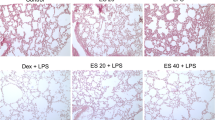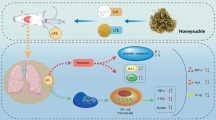Abstract
The acute lung injury (ALI) is a leading cause of morbidity and mortality in critically ill patients. Amygdalin is derived from the bitter apricot kernel, an efficacious Chinese herbal medicine. Although amygdalin is used by many cancer patients as an antitumor agent, there is no report about the effect of amygdalin on acute lung injury. Here we explored the protective effect of amygdalin on ALI using lipopolysaccharide (LPS)-induced murine model by detecting the lung wet/dry ratio, the myeloperoxidase (MPO) in lung tissues, inflammatory cells in the bronchoalveolar lavage fluid (BALF), inflammatory cytokines production, as well as NLRP3 and NF-κB signaling pathways. The results showed that amygdalin significantly reduced LPS-induced infiltration of inflammatory cells and the production of TNF-α, IL-1β, and IL-6 in the BALF. The activity of MPO and lung wet/dry ratio were also attenuated by amygdalin. Furthermore, the western blotting analysis showed that amygdalin remarkably inhibited LPS-induced NF-κB and NLRP3 activation. These findings indicate that amygdalin has a protective effect on LPS-induced ALI in mice. The mechanism may be related to the inhibition of NF-κB and NLRP3 signaling pathways.







Similar content being viewed by others
References
Grichnik, K.P., and T.A. D’Amico. 2004. Acute lung injury and acute respiratory distress syndrome after pulmonary resection. Seminars in Cardiothoracic and Vascular Anesthesia 8: 317–334.
Strauss, R.H., K.C. Palmer, and J.A. Hayes. 1976. Acute lung injury induced by cadmium aerosol. I. Evolution of alveolar cell damage. The American Journal of Pathology 84: 561–578.
Fein, A.M., and M.G. Calalang-Colucci. 2000. Acute lung injury and acute respiratory distress syndrome in sepsis and septic shock. Critical Care Clinics 16: 289–317.
Gunther, A., C. Siebert, R. Schmidt, S. Ziegler, F. Grimminger, M. Yabut, B. Temmesfeld, D. Walmrath, H. Morr, and W. Seeger. 1996. Surfactant alterations in severe pneumonia, acute respiratory distress syndrome, and cardiogenic lung edema. American Journal of Respiratory and Critical Care Medicine 153: 176–184.
Shen, W., J. Gan, S. Xu, G. Jiang, and H. Wu. 2009. Penehyclidine hydrochloride attenuates LPS-induced acute lung injury involvement of NF-kappaB pathway. Pharmacological Research 60: 296–302.
Covert, M.W., T.H. Leung, J.E. Gaston, and D. Baltimore. 2005. Achieving stability of lipopolysaccharide-induced NF-kappaB activation. Science 309: 1854–1857.
Ghosh, S., M.J. May, and E.B. Kopp. 1998. NF-kappa B and Rel proteins: evolutionarily conserved mediators of immune responses. Annual Review of Immunology 16: 225–260.
Kolb, M., P.J. Margetts, D.C. Anthony, F. Pitossi, and J. Gauldie. 2001. Transient expression of IL-1beta induces acute lung injury and chronic repair leading to pulmonary fibrosis. The Journal of Clinical Investigation 107: 1529–1536.
Liu, S., G. Feng, G.L. Wang, and G.J. Liu. 2008. p38MAPK inhibition attenuates LPS-induced acute lung injury involvement of NF-kappaB pathway. European Journal of Pharmacology 584: 159–165.
Moertel, C.G., T.R. Fleming, J. Rubin, L.K. Kvols, G. Sarna, R. Koch, V.E. Currie, C.W. Young, S.E. Jones, and J.P. Davignon. 1982. A clinical trial of amygdalin (Laetrile) in the treatment of human cancer. The New England Journal of Medicine 306: 201–206.
Park, H.J., S.H. Yoon, L.S. Han, L.T. Zheng, K.H. Jung, Y.K. Uhm, J.H. Lee, J.S. Jeong, W.S. Joo, S.V. Yim, et al. 2005. Amygdalin inhibits genes related to cell cycle in SNU-C4 human colon cancer cells. World Journal of Gastroenterology 11: 5156–5161.
Paoletti, I., V. De Gregorio, A. Baroni, M.A. Tufano, G. Donnarumma, and J.J. Perez. 2013. Amygdalin analogues inhibit IFN-gamma signalling and reduce the inflammatory response in human epidermal keratinocytes. Inflammation 36: 1316–1326.
Hwang, H.J., H.J. Lee, C.J. Kim, I. Shim, and D.H. Hahm. 2008. Inhibitory effect of amygdalin on lipopolysaccharide-inducible TNF-alpha and IL-1beta mRNA expression and carrageenan-induced rat arthritis. Journal of Microbiology and Biotechnology 18: 1641–1647.
Heikkila, R.E., and F.S. Cabbat. 1980. The prevention of alloxan-induced diabetes by amygdalin. Life Sciences 27: 659–662.
Ruffini, E., A. Parola, E. Papalia, P.L. Filosso, M. Mancuso, A. Oliaro, G. Actis-Dato, and G. Maggi. 2001. Frequency and mortality of acute lung injury and acute respiratory distress syndrome after pulmonary resection for bronchogenic carcinoma. European Journal of Cardio-Thoracic Surgery 20: 30–36. discussion 36–37.
Meduri, G.U., S. Headley, G. Kohler, F. Stentz, E. Tolley, R. Umberger, and K. Leeper. 1995. Persistent elevation of inflammatory cytokines predicts a poor outcome in ARDS. Plasma IL-1 beta and IL-6 levels are consistent and efficient predictors of outcome over time. Chest 107: 1062–1073.
Meduri, G.U., G. Kohler, S. Headley, E. Tolley, F. Stentz, and A. Postlethwaite. 1995. Inflammatory cytokines in the BAL of patients with ARDS. Persistent elevation over time predicts poor outcome. Chest 108: 1303–1314.
Zhang, X., K. Song, H. Xiong, H. Li, X. Chu, and X. Deng. 2009. Protective effect of florfenicol on acute lung injury induced by lipopolysaccharide in mice. International Immunopharmacology 9: 1525–1529.
Goodman, R.B., J. Pugin, J.S. Lee, and M.A. Matthay. 2003. Cytokine-mediated inflammation in acute lung injury. Cytokine & Growth Factor Reviews 14: 523–535.
Reutershan, J., A. Basit, E.V. Galkina, and K. Ley. 2005. Sequential recruitment of neutrophils into lung and bronchoalveolar lavage fluid in LPS-induced acute lung injury. American Journal of Physiology—Lung Cellular and Molecular Physiology 289: L807–L815.
Tak, P.P., and G.S. Firestein. 2001. NF-kappaB: a key role in inflammatory diseases. The Journal of Clinical Investigation 107: 7–11.
Karin, M., and F.R. Greten. 2005. NF-kappaB: linking inflammation and immunity to cancer development and progression. Nature Reviews. Immunology 5: 749–759.
Frank, J.A., J.F. Pittet, C. Wray, and M.A. Matthay. 2008. Protection from experimental ventilator-induced acute lung injury by IL-1 receptor blockade. Thorax 63: 147–153.
Bauernfeind, F.G., G. Horvath, A. Stutz, E.S. Alnemri, K. MacDonald, D. Speert, T. Fernandes-Alnemri, J. Wu, B.G. Monks, K.A. Fitzgerald, et al. 2009. Cutting edge: NF-kappaB activating pattern recognition and cytokine receptors license NLRP3 inflammasome activation by regulating NLRP3 expression. The Journal of Immunology 183: 787–791.
van de Veerdonk, F.L., M.G. Netea, C.A. Dinarello, and L.A. Joosten. 2011. Inflammasome activation and IL-1beta and IL-18 processing during infection. Trends in Immunology 32: 110–116.
Author information
Authors and Affiliations
Corresponding author
Ethics declarations
Conflict of Interest
The authors declare that they have no conflict of interest.
Rights and permissions
About this article
Cite this article
Zhang, A., Pan, W., Lv, J. et al. Protective Effect of Amygdalin on LPS-Induced Acute Lung Injury by Inhibiting NF-κB and NLRP3 Signaling Pathways. Inflammation 40, 745–751 (2017). https://doi.org/10.1007/s10753-017-0518-4
Published:
Issue Date:
DOI: https://doi.org/10.1007/s10753-017-0518-4




